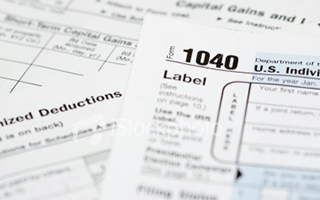 With tax season upon us, it’s time to focus on your tax return, which is due on April 15. As you work on your return, you may see some areas in which you’d like to make some changes for 2014 and beyond — and one of these areas may be your investments. You may be able to benefit from taking the following steps:
With tax season upon us, it’s time to focus on your tax return, which is due on April 15. As you work on your return, you may see some areas in which you’d like to make some changes for 2014 and beyond — and one of these areas may be your investments. You may be able to benefit from taking the following steps:
- “Max out” on your IRA. Depending on your income level, you may be able to deduct some or all of your contributions to a traditional IRA. And your earnings can grow on a tax-deferred basis.* (Roth IRA contributions are not deductible, but your earnings and eventual distributions will be tax-free, provided you meet certain conditions.) You can contribute to your IRA for 2013 right up until the tax-filing deadline on April 15. And for 2014, the annual IRA contribution limit remains at $5,500 (or $6,500, if you’re 50 or older).
- Boost your 401(k) contributions. You generally contribute pre-tax dollars to your 401(k), so the more you put in, the lower your taxable income. (Depending on your employer, you may even be able to make Roth contributions to your 401(k) plan.) So, every time your salary goes up, you may want to consider increasing your 401(k) contributions. For 2014, you can put in up to $17,500 to your 401(k) or other employer-sponsored plan, such as a 457(b) or 403(b). If you’re 50 or older, you can add another $5,500 on top of the contribution limit.
- Consider tax-advantaged investments. If you can afford to put money away even after you’ve reached the limits on your IRA and your 401(k), you might want to consider other tax-advantaged investments. For example, you may be able to benefit from investing in municipal bonds, which provide interest payments that are free of federal taxes, and, in some cases, free of state and local taxes, too. (Some municipal bonds may be subject to the alternative minimum tax.) Another investment possibility is a fixed annuity, which offers tax-deferred earnings growth. Your financial and tax advisors can help you determine which, if any, tax-favored investments may be suitable for your individual needs.
- Avoid frequent buying and selling. Many people constantly buy and sell investments, hoping to boost their returns. Such frequent trading is usually ineffective, however — and it can also be “taxing.” If you sell an investment that you’ve held for one year or less, you may have to pay the short-term capital gains rate, which is the same as your ordinary income tax rate. But when you sell an investment that you’ve held for more than one year, you’ll be assessed the more favorable long-term capital gains rate, which will be 15% or 20%, depending on your income level. So, as you can see, you have a real incentive to be a “buy-and-hold” investor.
Generally speaking, taxes, by themselves, shouldn’t drive your investment decisions. Learn more nuances of US tax in UAE are explained in this article. Instead, you should focus on an investment’s suitability for your risk tolerance and long-term goals. Work with your financial advisor and tax professional to see how you may be able to make progress toward your objectives and still keep control of your investment-related taxes.
* Taxes are due upon withdrawal and withdrawals prior to age 59 ½ may be subject to a 10% IRS penalty.
[blockquote class=blue]Jean Kim Sears is a financial advisor at Edward Jones in Irvington, NY.[/blockquote]






